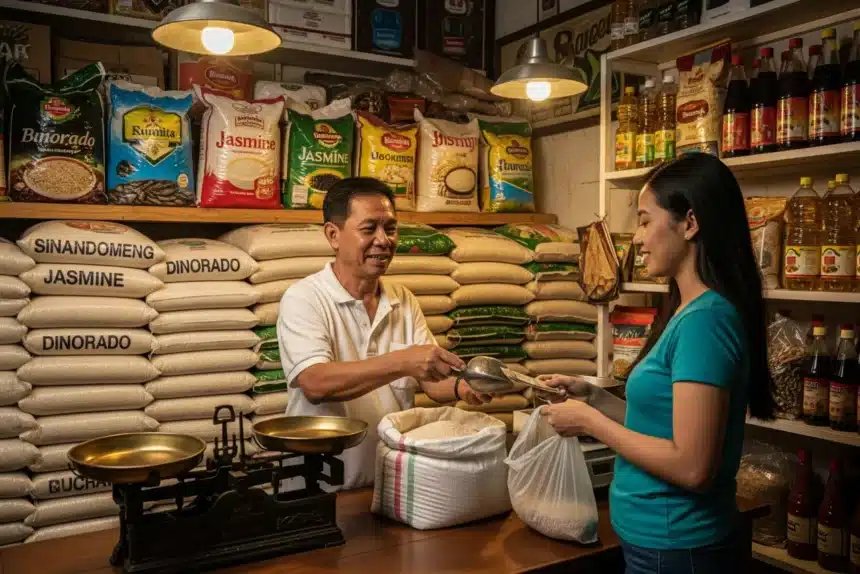Rice is the heart of every Filipino meal. Whether it’s breakfast with tuyo, lunch with adobo, or dinner with sinigang, one thing is constant: there’s always rice on the table. Because rice is a staple food, the business of selling it remains one of the most reliable ventures in the Philippines. Even in times of crisis, demand never disappears. In fact, rice is often recession-proof, making it a compelling choice for small entrepreneurs.
- 🌾 Why Choose Rice Retailing?
- 💰 Capital Requirements and Costs
- 📑 Permits and Legal Requirements
- 🛒 Choosing Your Rice Supplier
- 🏪 Location Matters
- 🌾 Rice Varieties to Sell
- ✅ Pros of a Rice Retailing Business
- ❌ Risks and Challenges
- 📊 Table 2: Common Risks vs. Preventive Measures
- 📈 Growing and Scaling Your Rice Business
- ❓ Frequently Asked Questions (FAQ)
- ✨ Final Reflection: Is Rice Retailing the Right Business for You?
- 🌾 References
But how do you turn this staple into a sustainable business? Starting a rice retailing business might sound simple – buy rice from suppliers and sell it by the kilo. Yet the reality involves licenses, supplier relationships, quality control, and strategic location. If you want to stand out in a highly competitive market where almost every barangay has a rice dealer, you’ll need more than just sacks and a weighing scale.
In this guide, we’ll break down everything you need to know about starting a rice retailing business in the Philippines, from capital requirements to sourcing, from legal permits to marketing strategies. We’ll also discuss risks, practical tips, and how to grow from a small retail store to a larger operation.
If you’ve been thinking of investing in a business that connects directly to the daily lives of Filipinos, rice retailing could be the negosyo that sustains your family for years to come. Let’s dive in.
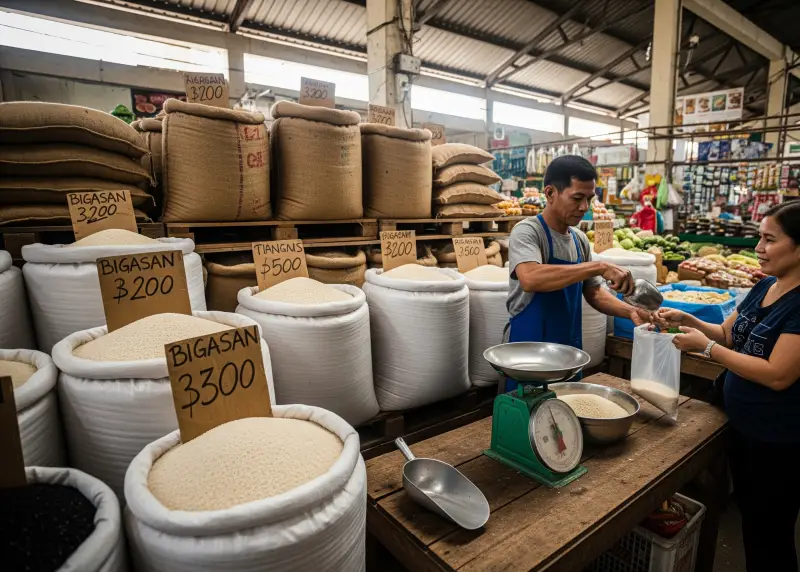
🌾 Why Choose Rice Retailing?
The rice retailing business has one major advantage: guaranteed demand. Unlike fads or seasonal businesses, rice is consumed daily by millions of Filipinos. This steady demand translates to a consistent customer base, ensuring that your business has a solid foundation.
Another reason entrepreneurs turn to rice retailing is flexibility. You can start small with just a few sacks and scale as your capital grows. Some retailers begin from home, while others open stalls in public markets or near residential areas.
Rice also offers multiple varieties, which means you can cater to different market segments. For example, budget-conscious customers may prefer NFA rice, while middle-class families often buy well-milled or premium varieties like Jasmine or Dinorado. This diversity allows you to position your store strategically depending on your target market.
💰 Capital Requirements and Costs
Starting a rice retailing business doesn’t require millions. You can start small with as little as ₱30,000–₱50,000, depending on your scale and location. However, capital can quickly increase if you plan to open a larger store with more varieties of rice.
Typical Costs Breakdown:
- Initial Rice Inventory (10–20 sacks): ₱20,000–₱40,000
- Weighing Scale (Digital or Manual): ₱2,000–₱10,000
- Rice Storage Containers or Display Boxes: ₱5,000–₱15,000
- Shop Renovation / Stall Rental: ₱5,000–₱20,000
- Business Permits and Fees: ₱2,000–₱10,000
📊 Table 1: Example Startup Costs for a Small Rice Store
| Expense Item | Estimated Cost (₱) | Notes |
|---|---|---|
| Rice Inventory (15 sacks) | 30,000 | Assuming ₱2,000/sack |
| Weighing Scale | 5,000 | Digital, more accurate |
| Display Containers | 10,000 | Glass or acrylic bins |
| Stall/Shop Rental | 8,000 | Small market space |
| Permits & Licenses | 5,000 | Local government fees |
| Total | 58,000 | Approximate |
Capital can be adjusted depending on your budget. Some home-based retailers even start with just 5 sacks of rice.
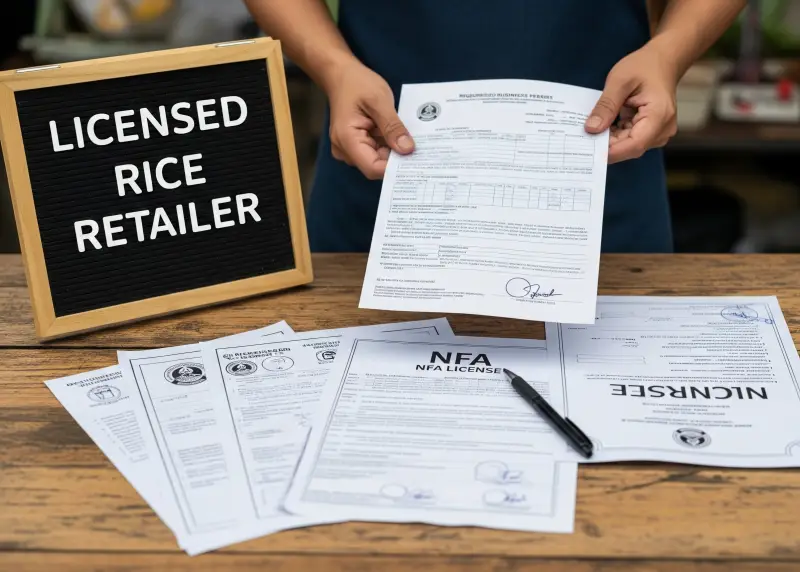
📑 Permits and Legal Requirements
Running a rice retailing business requires compliance with both national and local regulations. This ensures that your business is legal and trusted by customers.
Essential Permits You Need:
- DTI Business Registration (for sole proprietorship) or SEC Registration (if corporation/partnership).
- Barangay Clearance for your store’s location.
- Mayor’s Business Permit from your LGU.
- BIR Registration for official receipts and taxes.
- NFA License (National Food Authority) for rice trading and retailing.
The NFA License is particularly important because rice is a regulated commodity. Without it, your business can be penalized. Application involves submitting documents like your DTI certificate, BIR registration, and paying licensing fees.
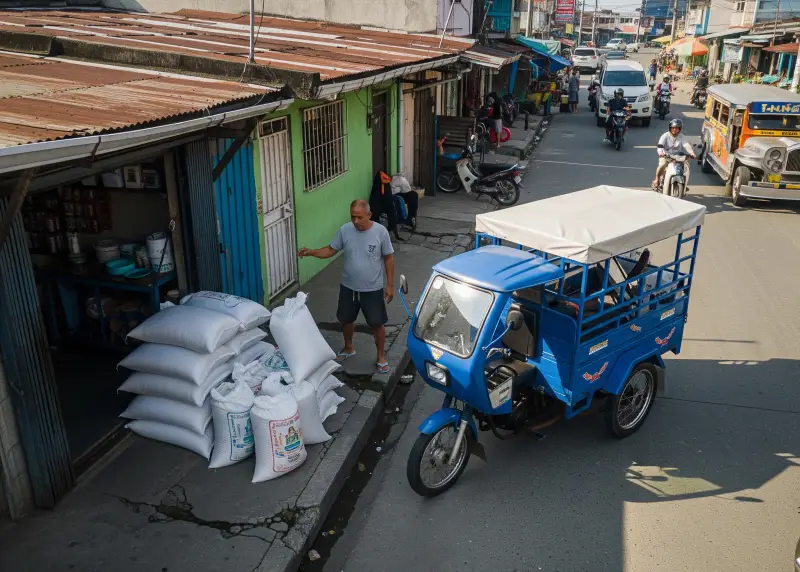
🛒 Choosing Your Rice Supplier
Your rice supplier is the backbone of your business. The quality, freshness, and price of your rice will directly affect your sales and reputation. Partnering with NFA-accredited suppliers or trusted rice millers gives you a consistent supply chain, but it’s equally important to evaluate them for reliability. For instance, a supplier that consistently delivers on time prevents you from running out of stock – delays can push customers to competitors, which hurts your credibility.
When choosing a supplier, ask these questions:
- Do they deliver on time, even during peak demand seasons?
- Can they provide a wide variety of rice types (NFA, well-milled, premium, specialty)?
- Are their prices stable and competitive with other sources?
- Do they allow credit terms for loyal buyers to help with cash flow?
- How is their track record with other retailers?
Establishing good relationships with suppliers is also crucial. Loyal customers often get better prices, priority delivery, or more flexible payment arrangements. Tip: Work with at least two suppliers instead of relying on one source. This way, if one raises prices or faces supply shortages, you have a fallback. The strongest rice retailers often cultivate relationships not just with wholesalers but also with farmers and millers, giving them access to fresher, cheaper inventory.
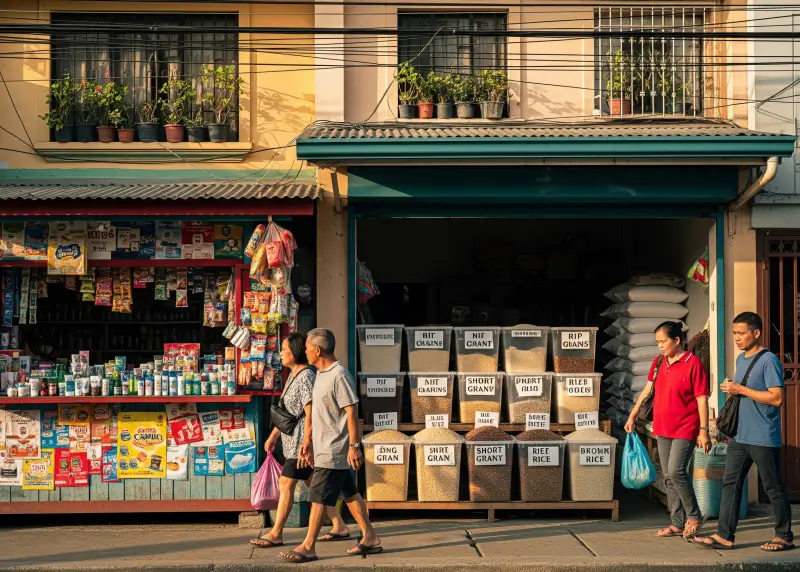
🏪 Location Matters
Location can make or break your rice retailing business. Unlike luxury items, rice is a commodity that customers usually buy from the most convenient source. People don’t want to travel far just to buy rice, so your store must be strategically placed in an area where people naturally pass by or gather.
Best Locations for Rice Retailing:
- Public markets with heavy foot traffic.
- Near subdivisions or densely populated barangays.
- Close to sari-sari stores or neighborhood groceries.
- Within transport terminals, jeepney stops, or busy intersections.
A good location doesn’t always mean the most expensive rental space. Some successful rice retailers start from their homes, especially if their barangay has many residents but limited rice sources. The key is visibility and accessibility – can people easily spot your store and buy from you without hassle?
If you’re operating in a market, make your stall attractive. Use clear bins to display rice varieties, label prices clearly, and keep the area neat. A clean, organized stall builds trust and assures customers that the rice they’re buying is fresh and safe. Remember, in rice retailing, convenience and trust often matter more than flashy marketing.
🌾 Rice Varieties to Sell
Rice isn’t a one-size-fits-all product. Filipino households have different preferences based on income, taste, and cooking habits. By offering a range of varieties, you widen your customer base and prevent your store from being seen as “just another rice seller.”
Popular Rice Varieties in the Philippines:
- NFA Rice – The cheapest option, ideal for budget-conscious households. Sold at controlled prices, it’s usually in high demand.
- Well-Milled Rice – The “standard” rice for most middle-income families, balancing quality and price.
- Premium Varieties (Dinorado, Jasmine, Sinandomeng) – More aromatic and tastier, often bought by upper-income families or for special occasions.
- Brown Rice/Red Rice – Marketed as healthier, these have a growing niche among health-conscious Filipinos.
Your pricing strategy should align with your target market. For example, if your stall is in a wet market, you might focus more on NFA and well-milled rice. But if you’re near a gated subdivision, stocking premium rice makes sense. Tip: Display rice in transparent bins or glass containers. This lets customers see the grain size, cleanliness, and quality – giving them confidence to buy from you instead of someone else.
Retailers who experiment with niche options like organic rice or mixed-grain rice can also carve out a special market. While these don’t sell in high volume yet, they often have higher profit margins.
✅ Pros of a Rice Retailing Business
The rice retailing business comes with strong advantages that few other ventures can match. First and foremost, rice has daily, guaranteed demand – every Filipino family eats rice multiple times a day, regardless of economic conditions. This makes rice a recession-proof business that provides steady sales.
Another advantage is flexibility in capital. You can start small with just a handful of sacks and grow into a full-fledged rice depot. The business is also relatively easy to understand – no need for advanced skills or complicated systems, just good record-keeping and customer service.
Rice retailing also offers diversification opportunities. You can sell different varieties at different price points, catering to both budget-conscious and premium customers. This flexibility allows you to adapt to shifts in customer demand or price changes.
Finally, the cash flow is steady because customers typically buy rice daily or weekly. Unlike seasonal businesses, there’s rarely a time when demand slows down, making rice retailing one of the most stable negosyo options.
❌ Risks and Challenges
Despite its advantages, rice retailing is not without risks. The biggest challenge is high competition. Almost every barangay has rice dealers, and customers often choose based on convenience or price. This makes it harder to stand out unless you emphasize quality and service.
Another issue is thin profit margins. Typically, you earn only ₱2–₱5 per kilo, which means you need to sell in volume to make good profits. Combined with competition, this puts constant pressure on your pricing strategy.
Price volatility is another problem. Factors like typhoons, supply chain disruptions, or government import policies can suddenly increase rice prices. If you’re not careful, you may end up selling at lower margins or even losses.
There’s also the risk of spoilage or infestation if rice isn’t stored properly. Moisture and pests can ruin entire sacks, cutting into your profits. Lastly, regulatory compliance is strict, especially with the NFA. Failure to secure the right permits could lead to penalties or closure.
For these reasons, while rice retailing is stable, it requires discipline, adaptability, and careful planning to survive and thrive.
📊 Table 2: Common Risks vs. Preventive Measures
| Risk | Preventive Measure |
|---|---|
| Rice spoilage | Store rice in airtight bins, keep area dry and clean |
| Supplier problems | Have multiple suppliers |
| Price changes | Adjust pricing quickly, diversify varieties |
| Competition | Build loyal customers with service & consistent quality |
📈 Growing and Scaling Your Rice Business
Once your business is stable, expansion opportunities include:
- Adding more rice varieties.
- Offering delivery services to sari-sari stores.
- Partnering with restaurants or carinderias.
- Opening multiple stalls in nearby barangays.
Some rice retailers eventually evolve into wholesalers, supplying other small retailers. This requires bigger capital but also brings larger profits.
❓ Frequently Asked Questions (FAQ)
1. How much capital do I need to start a rice retailing business?
You can start with ₱30,000–₱50,000 for a small home-based store. A market stall with multiple rice varieties may need ₱60,000–₱100,000 or more.
2. Do I need a license from the NFA to sell rice?
Yes. The National Food Authority regulates rice trading. An NFA license ensures your business is legal and compliant.
3. How much profit can I make per sack of rice?
Profits range from ₱100–₱300 per sack, depending on your pricing. While margins are thin, volume and consistency drive earnings.
4. Where do rice retailers usually buy their stock?
Most source from NFA-accredited suppliers, rice millers, or wholesalers in big markets like Divisoria. Some provinces also allow direct sourcing from farmers.
5. Can I sell rice online?
Yes! Some retailers now offer rice via Facebook Marketplace or delivery apps. However, logistics and trust are key challenges.
6. What kind of rice sells fastest?
Well-milled and NFA rice are the most common daily buys. Premium varieties sell well during holidays or paydays.
7. How do I prevent rice spoilage?
Store rice in airtight containers, avoid damp areas, and regularly clean storage bins. Pest control is also essential.
8. Is rice retailing still profitable in 2025?
Yes. Despite thin margins, daily demand ensures steady cash flow. Profitability depends on efficient operations and customer loyalty.
9. Do I need employees for a rice store?
Small stores can be managed by one person. Larger operations may require helpers for weighing, repacking, or deliveries.
10. What’s the biggest mistake rice retailers make?
Relying on a single supplier and ignoring spoilage risks. Successful retailers diversify suppliers and practice strict quality control.
✨ Final Reflection: Is Rice Retailing the Right Business for You?
The rice retailing business is one of the most practical and reliable ventures in the Philippines. It doesn’t rely on trends, fads, or luxury spending – it taps directly into the everyday needs of millions of Filipino households. Unlike other businesses where demand may fluctuate, rice guarantees daily sales, making it one of the most stable negosyo choices.
But stability doesn’t mean it’s easy. Rice retailing is a volume game, where profit margins per kilo are small but add up over time. To succeed, you’ll need discipline, consistency, and the patience to manage thin margins. Location and supplier relationships are everything, and without them, your business could struggle.
At the same time, rice retailing gives you something many businesses don’t: a chance to scale naturally. With experience, you can expand from a small home-based store into a market stall, then into wholesale supply. Each stage teaches you valuable lessons about inventory, customer service, and resilience.
If you’re looking for a negosyo that fits the Filipino way of life, rice retailing might just be the most “Pinoy-proof” business idea out there. It’s not flashy, but it’s steady, reliable, and deeply rooted in our culture. And in business, sometimes the simplest ideas are the ones that last the longest.
🌾 References
-
FilipiKnow – Bigasan Business 2025: How To Start, Capital, Profit
-
Moneymax PH – How to Start a Bigasan: Rice Seller Guide



